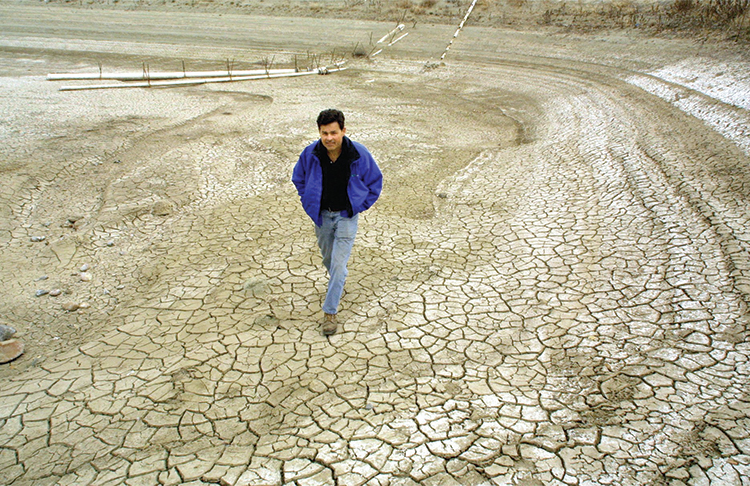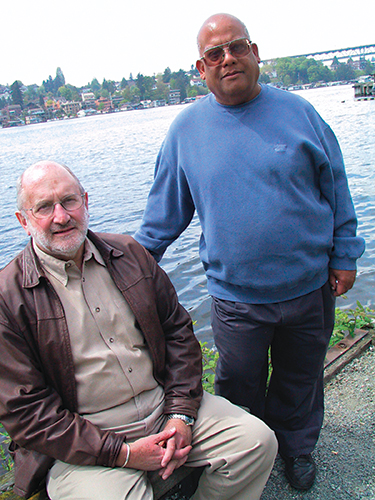The Pacific Northwest’s reputation as a wet place is, well, all wet. While you might look at a map of the green swath that runs from Vancouver B.C. down through Eugene, Ore., and think we are swimming in water year-round, you'd be wrong.
The reason, writes Pulitzer Prize-winning writer William Dietrich in his book Northwest Passage: The Great Columbia River, is that most of the moisture that hits the area never makes it east of the Cascade Mountains. That leaves the entire area east of the mountains a high desert prairie that draws less rain than Los Angeles (a measly five inches per year, compared to 39 in Seattle and as many as 200 in the Pacific Northwest rain forests).
Lewis and Clark called the stark landscape “the Great Columbia Plain,” since it drains the nation’s second biggest river, fourth largest in North America. The only way to bring water to that arid landscape was to dam the river. “This then was the rally for water,” Dietrich says of the dreams to dam the Columbia.
The Depression-era promises initially seemed extravagant: water enough for 100,000 farms; a water highway for commercial river traffic from the Pacific Ocean to Idaho; power for factories to employ more than 200,000 new industrial workers.
And sure enough, those promises were fulfilled. But today the situation has taken an unexpected, dramatic turn for the worse. The Pacific Northwest, despite its reputation, will be facing water shortages right when it’s most needed.
Falling water tables, coupled with high summertime water use, has made some water systems across the state vulnerable to the point of running dry, according to state Department of Health officials. At particular risk are shallow wells that depend on rapid, local renewal from rainfall or stream flows.
But the long-term water situation is even more precarious. The snow pack that provides some of the water to power cities, supply drinking water and irrigate farmland is shrinking fast.

Arid scenes are becoming more common in the Pacific Northwest.
Earlier this year, researchers announced new findings that a warming climate the last 50 years has, through early melting, relentlessly reduced the water content of the Pacific Northwest’s springtime snowpack. From 1950 through 1992, the amount of water found April 1 in snowpack declined steadily throughout the region, as much as 60 percent in some places at moderate elevations, according to Philip Mote, a research scientist with the Pacific Northwest Climate Impacts Group at the University of Washington.
The summers of the 1990s brought a taste of sharply reduced summer flows. In 1994 farmers in some irrigation districts in the Yakima Valley lost up to 65 percent of their irrigation water — and probably lost hundreds of millions of dollars. In many urban areas, water districts struggled to curb consumers’ demand for water. As water levels in reservoirs dropped, the remaining water grew murkier, leading to problems with water quality.
Very dry weather last summer and fall — the SeaTac weather station reported July-November precipitation as the second driest on record — caused record low flows on some rivers and prompted the Washington Department of Ecology’s drought coordinator to say as early as August, “At this point, small amounts of rain make very little difference, and large amounts of rain make a difference for a limited time.”
“Scarcity has not been seen on this scale before,” says UW Marine Affairs Professor Ed Miles. The region’s water-resources system just doesn’t have the capacity to meet present and anticipated demands, he says. “This region faces severe difficulties even if the climate doesn’t change as various models predict it will.”
“The whole ecosystem in the Northwest will just unravel and fish are just the tip of the iceberg,” says Aquatic and Fishery Sciences Professor Robert Naiman, when asked what could happen in the next 50 years. “Everything will change drastically — drastically.”
Engineering Professor Dennis Lettenmaier says climate change in the next 50 years is probably going to result in the grim regional choice of salmon or hydropower, but not both.
Adding to the coming crisis is the growing tension between Eastsiders and Westsiders in Washington and Oregon. The two groups already point fingers at each other — those “206ers” being among the dismissive terms Eastsiders have for the urbanites in Seattle’s area code, while some Westsiders are just as quick to dismiss a 60-year tradition of irrigated farming.
When talking about water scarcity, what’s particularly perplexing is that the region may actually have heavier overall annual river flows because of climate change, according to Civil and Environmental Engineering Professor Richard Palmer. The problem for a warmer and wetter Pacific Northwest is the timing of precipitation — how much falls as rain instead of snow and how long the snow pack lasts into the summer, Palmer says.
Seeing as how we’re already extracting the maximum amount of water possible, Palmer says, the cumulative effect of climate change shifting summer flows to earlier in the year could mean 30 percent less water right when we need it the most. “That’s our biggest challenge in my opinion.”
He points to the Sultan River, which fills Everett’s Spada Reservoir, as an example. According to one scientific model, climate change will mean more winter precipitation falling as rain rather than snow. The resulting snowpack will be smaller and could melt toward the end of winter rather than in June and July, as it typically does now. Compared to today, flows could be cut 33 to 48 percent during May through September when demand is high.
Beyond human uses, lower stream flows in the summer mean less habitat and higher stream temperatures for fish and other aquatic organisms. This could play havoc with their physiology and even their ability to survive.
Ironically, the greater amount of rainfall and earlier runoffs means we also can expect higher than usual river flows in late winter and spring. In the face of the resulting flooding, the U.S. Army Corps of Engineers and others will likely be under pressure to pull down reservoirs even though that water will be much needed later in the year, Palmer says.
“Unlike other things that society depends on — such as supplies of energy, of minerals for industrial processes, even foods — no substitutes exist for most water uses.”
Jim Karr, UW professor of fisheries and public affairs
So what’s the answer? Our Depression-era engineers would have built more dams to increase the capacity of current reservoirs or create new ones. Today there is also talk of pumping water from aquifers like the one beneath the Rathdum Prairie near Spokane that has Washington and Idaho wrestling over its control. The Puget Sound region might also find a new supply from an aquifer that appears to sit under North Bend.
But Jim Karr, UW professor of fisheries and public affairs, warns of trying to narrowly focus and engineer our way out of very complex challenges.
“I’m concerned that the issue will be seen as one that is about water, the H2O, the fluid,” he says. “That perspective doesn’t see the connection to the broader context of water and associated resources. It does not see the fish. It doesn’t see the broader biology of our freshwater systems.
“Moreover, it does not see the profound importance of water and the flow of water to coastal environments, the areas of salt water that do not provide drinking water but that do provide a vast array of other goods and services crucial to the success of our region.
“Second, I worry that we will forget that it is not water that we depend upon but the water cycle,” Karr says. As part of that cycle, water evaporating from oceans and waterways becomes clouds laden with rain and snow that falls, percolating into the soil, being taken up by plants, filling rivers, streams and lakes or remaining for long periods of time as snow and ice in some areas.

UW Fisheries and Public Affairs Professor Jim Karr (seated) and Marine Affairs Professor Ed Miles say the coming water shortages will dwarf past droughts. Scarcity has not been seen on this scale before, warns Miles. Photo by Kathy Sauber.
“That is the larger megasystem that provides not only water for drinking and industry and agriculture, but defines the climate that we and others experience. We must be very careful about water control engineering when it short-circuits — or even destroys — the water cycle.”
An immediate problem with nearing the limits of our water resources is that we have “less margin of safety to cope with the unexpected,” says Miles, a founding member of the Climate Impacts Group, a research group based at the UW that strives to help businesses, agencies and other organizations incorporate short-, medium- and long-term climate forecasts into their planning.
That applied approach is coupled at the UW with some of the nation’s best research and teaching on climate, packaged last year under the new Program on Climate Change. UW climate researchers in the last decade have discerned or helped define the effects of a number of Pacific Northwest, North American and global climate patterns.
The more we know about El Niño, La Niña, the Pacific Decadal Oscillation and other climate cycles, the better our forecasts and planning, Miles says. For example in 1987 the region had a wet winter and spring, followed by virtually no rain from July through December. If we’d known that was the risk, Miles says, we might have instituted aggressive conservation measures that summer and avoided water supply shortages in the fall.
Miles says establishing a regional climate monitoring service would improve forecasts and help us learn what different climate cycles mean for the region. Another challenge is that water management is highly fragmented. No single entity is in charge of Columbia River water when droughts hit. Entities from the international level down to the county, private and tribal level can have conflicting goals, and standards for water quality and quantity across basins are often inconsistent.
Still the biggest challenge is planners and others who continue dealing, “only with population growth and the Endangered Species Act demands,” Miles says.
Right now, says Naiman, if it weren’t for the Endangered Species Act or the area’s water problem would be a lot worse. “It’s one of the strongest pieces of legislation we have for protecting the environment. Even that won’t be enough in coming decades,” he says.
Naiman says we’re going to see unimaginable changes in the next 50 years if we continue on in the same ways.
“It’s as if most people don’t truly understand where their water comes from, how it’s collected or how it is carried into their homes,” he says. “Everyone should be knowledgeable about the soundness of the infrastructure and how water is treated, as well as understanding the broad ecological consequences of developing water supplies.”
Using today’s science to plan for tomorrow’s water policies, taking personal responsibility for how we use resources like water and power, taking more steps to conserve and pursuing growth management are all possible ways out of this mess.
“The University needs to be relevant to these issues, to foster debates and discussions and to provide leadership in helping find solutions,” Naiman adds.
Of course, scientists alone can’t show the way. Politicians and the citizens who elect them have to have the courage to ask the right questions about how to solve this problem and, then, to implement the answer.
“Unlike other things that society depends on — such as supplies of energy, of minerals for industrial processes, even foods — no substitutes exist for most water uses,” Karr says.
“Everyone needs a supply of fresh clean water every day.”